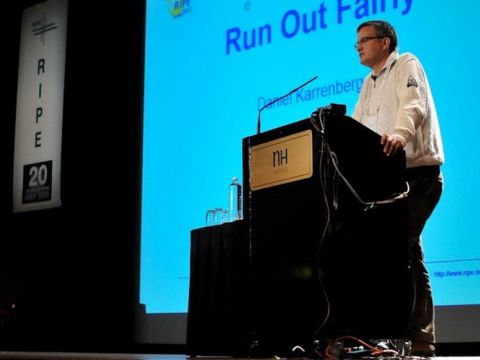Arguably, Karrenberg’s contributions, coupled with innovations from Cerf, Landweber, and Kahn, created today’s modern internet.
Karrenberg’s first taste of networking came during a summer job at Microsoft’s Bellevue, Washington headquarters in 1982, while he was still a computer science student at Germany’s Dortmund University. While at the young American company (Microsoft had about 220 employees then, and had just launched its first computer mouse) he was introduced to Usenet, a news and electronic mail network. “This is great, I want this at home and at my university,” Karrenberg recalls thinking at the time.

When Karrenberg returned to Europe after that summer at Microsoft, he sought out others who wanted a Usenet-like connection in Europe as well. He ended up coordinating the creation of EUnet, the European version of Usenet.
The big problem with adoption of early European networks like EUnet was overly expensive long-distance and international rates for phone calls and data transfer. There was a central European node and individual country nodes, which were largely segregated thanks to telecom tariffs. The tariff boundaries closely followed political boundaries, so sending data between countries frequently was extremely pricey.
After university, Karrenberg ended up at the Centrum Wiskunde & Informatica (CWI) in Amsterdam and while there, helped build a central European backbone node that was separate from the expensive telecom network. Leveraging that backbone was the key, Karrenberg realized, to lowering the cost and growing the use of EUnet. He was spot-on.
As traffic and the number of nodes on the nascent EUnet network grew, Karrenberg had the chance (and money) to move completely away from telephony to cheaper data transmission services. Ultimately, he was able to lease a circuit for the exclusive use of EUnet.
Intercontinental circuits were the cheapest, so naturally that is what Karrenberg leased. With the circuit lit up he was able to send data from CWI to the Center for Seismic Studies in Arlington, Virginia. It was the first intercontinental interconnection that wasn’t funded by a government research or military project.
Karrenberg says once he had that circuit, it made no sense to run the “store and forward” protocol on it, so the team at CWI ran IP on it and made it an internet link. That move paved the way for EUnet to connect with NSFNET and CERN’s TCP/IP connections, ultimately creating the internet we know today. Karrenberg grew EUnet circuit by leased circuit. “Once you had enough volume to finance a leased circuit, you had some time to grow before you reached the bandwidth of that circuit,” Karrenberg says.
After the major networks adopted IP, Karrenberg helped establish Réseaux IP Européens (RIPE), a volunteer organization that coordinated internet routing in Europe. By the ’90s, Karrenberg realized some of that coordination needed formal oversight, even though RIPE was originally designed to operate without a central body calling the shots. In order to keep the integrity of the original RIPE, the association was organized independently and called Réseaux IP Européens Network Coordination Centre (RIPE NCC). RIPE NCC was responsible for distributing IP addresses for the newly hatched internet. Today it administers IPv6 addresses to European internet service providers.
Karrenberg led RIPE NCC until 1999 and now serves as the organization’s chief scientist. His work revolves around keeping the internet secure and stable. “In the developed parts of the world, the internet has become a utility like water, electricity and sewage,” says Karrenberg. “There is a lot of effort required and interest in keeping it working and developing.”